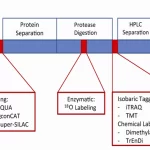
Unveiling the Synergy of Proteomics Data in Bioinformatics: Challenges and Successes in Multi-Omics Integration
August 27, 2023Unraveling the Intersection of Bioinformatics and Proteomics: Navigating the Maze of Multi-Omics Integration
Section 1: An Overview
The study of proteins at a large scale, known as proteomics, has dramatically changed over time, enhancing our grasp of biological systems. Advanced technologies like mass spectrometry, along with computing methods in bioinformatics, allow scientists to both identify and measure a large number of proteins. This essay explores how bioinformatics elevates the utility of proteomics data, reviews the analytical tools at our disposal, and delves into the complexities and triumphs of merging proteomics with other forms of biological data.
Section 2: Bioinformatics in the Proteomics Landscape
2.1 Identifying Proteins
Complex datasets emerging from proteomics experiments require specialized techniques for protein identification. Here, bioinformatics offers indispensable algorithms for sorting and assembling this data into recognizable proteins.
2.2 Quality Control
Mass spectrometry’s heightened sensitivity means that proteomics data can include anomalies or noise. Bioinformatics applications can eliminate these inaccuracies, ensuring a cleaner dataset for analysis.
2.3 Merging Datasets
The full potential of proteomics is realized when merged with other omics data, such as transcriptomics or genomics. This creates a more complete picture of cellular activity.
2.4 Meaningful Interpretation
The role of proteins and how they interact is essential in understanding biological processes. Bioinformatics contributes by contextualizing proteomic data within biological networks and pathways.
Section 3: Key Tools for Proteomic Analysis
The world of bioinformatics offers a rich array of specialized tools for analyzing proteomics data, such as:
3.1 ProteoWizard Suite
This toolkit is critical for tasks like multiple reaction monitoring and the analysis of mass spectrometer outputs.
3.2 STRING & MINT Resources
Both STRING and MINT function as extensive databases that document verified and anticipated protein interactions.
3.3 MaxQuant & OpenMS
These software solutions are pivotal for tasks related to quantitative proteomics, including the identification, quantification, and statistical evaluation of proteins.
3.4 pGlyco3
Focused on glycoproteome assessments, this software is gaining prominence in the exploration of cellular functions.
Section 4: Cross-Pollination with Other Omics Domains
4.1 Tying in Transcriptomics
Blending proteomics and transcriptomics can shed light on regulatory processes occurring after transcription.
4.2 Synchronizing with Genomics
Correlating genetic variations with protein levels can be made possible by linking genomics with proteomics data.
4.3 Integrating Metabolomics and Epigenomics
Converging proteomics with metabolomics and epigenomics adds depth to our understanding of metabolic pathways and gene regulation.
Section 5: The Roadblocks and Milestones in Data Fusion
5.1 Obstacles
The fusion of proteomics with other omics data is not without its hurdles, stemming from issues like data diversity and preprocessing complexities.
5.2 Victories
In spite of the challenges, there are numerous instances of successful multi-omics integrations, ranging from proteogenomics to metabolomics-proteomics unions.
Section 6: The Way Forward
As bioinformatics and proteomics continue to evolve, so too does their collective impact on our biological comprehension. While there are stumbling blocks, the prospects for medical breakthroughs and knowledge expansion are monumental. Advanced computational methodologies promise to bring even more valuable insights from the interplay between bioinformatics and proteomics.
Additional Considerations
1. Biomarker Discovery: Fusing proteomics with genomics or transcriptomics can pinpoint disease markers that have both genetic and protein-level expressions, which is especially valuable in oncology research.
2. Drug Target Search: The amalgamation of omics data can accelerate the discovery of drug targets. For example, proteins consistently overexpressed across various datasets may be ripe candidates for targeted therapy.
3. Systems Biology: A multi-omics approach enhances our ability to create precise models of complex biological systems.
4. Functional Exploration: Validating gene functions through proteomics adds an extra layer of confidence to genomics or transcriptomics findings.
5. Tailored Therapies: Combining genomics and proteomics can fine-tune treatment plans, with protein expression variations helping to inform medication selection.
The success of multi-omics integration hinges on robust computing and statistical methods to accommodate the intricacies inherent in each data type. A well-defined biological question can also act as a guidepost for both the integration and the interpretation of results.
As we march forward in technological prowess, the efficiency of integrating multiple omics data will likely improve, albeit with its own set of evolving challenges and considerations.
Ethical Aspects to Consider
1. Safeguarding Personal Information: As datasets become increasingly comprehensive and personalized, the emphasis on data privacy should also increase. Security measures need to be robust to protect the identities of individuals participating in multi-omics research.
2. Clear and Transparent Consent: When multi-omics studies rely on existing data for either comparison or validation, it’s essential to make sure that the initial data collection was conducted with the informed consent of the participants, extending to its use in multi-omics contexts.
Looking Ahead
1. Leveraging Machine Learning: Innovative machine learning algorithms are gradually making their mark in multi-omics data assimilation, revealing intricate connections across various biological dimensions that were earlier less understood.
2. Immediate Data Analysis: Technological breakthroughs are inching us closer to real-time analyses of omics data, with potential applications in areas like real-time health monitoring and diagnostics.
3. Method Consistency: As tools for omics data consolidation multiply, there’s a growing necessity for standard protocols. This ensures that the methodologies are mutually intelligible and that the results can be universally accepted.
4. Open-Access Repositories: The proliferation of well-integrated, publicly accessible databases will make it easier to share multi-omics data, thereby speeding up scientific advancements and allowing for more rigorous validation processes.
Final Remarks
The amalgamation of proteomics with other omics forms offers unparalleled avenues for dissecting biological processes at numerous layers of complexity. Even though obstacles exist in harmonizing this intricate data, continual upgrades in bioinformatics, machine learning, and statistical techniques are progressively boosting our capacity to glean substantial knowledge from these elaborate data sets. As we surmount these hurdles—technical, computational, and ethical—the integration of multiple omics fields could greatly benefit areas ranging from foundational biology to patient-centered medicine.
The Next Steps in Proteomics and Bioinformatics within Multi-Omics Science
As we peer into what lies ahead, it’s evident that integrating proteomics data with other omics varieties holds significant promise. Yet it’s equally clear that we’ve only scratched the surface. Researchers are still experimenting with optimal strategies for amalgamation and its application in clinical settings.
Bridging the Gap to Clinical Practice
1. Tailoring Medical Treatments: One of the most impactful outcomes of integrating multiple types of omics data could be personalizing medical interventions.
2. Pharmaceutical Innovations: Recognizing protein-level changes in the context of diseases, especially when correlated with other omics data, could lead to targeted drug development, potentially resulting in treatments that are both more effective and less harmful.
A Unified Approach to Research
1. Cross-Disciplinary Collaboration: A well-rounded comprehension of multi-omics data will demand a cooperative approach that brings together experts in various scientific domains.
2. Science Without Borders: Cross-discipline and even cross-border sharing of data, techniques, and tools can help reinforce the validity of scientific claims, thus accelerating research.
Obstacles to Overcome
1. Funding Requirements: As data scales up, so does the financial burden of storing and analyzing it. Efficient computational algorithms and cost-effective storage are becoming increasingly important.
2. System Compatibility: Successful amalgamation of multi-omics data requires tools and databases that can communicate effectively. This, in turn, necessitates the creation of global guidelines for how data is gathered, annotated, and disseminated.
Concluding Insights
Melding proteomics with other types of omics data is a dynamic field rich in both potential and challenges. The judicious use of bioinformatics is enabling us to untangle complex biological webs. In the long run, this will aid us in a better understanding of diseases, crafting more effective treatments, and pushing closer to the goal of personalized healthcare. However, as we navigate this exciting avenue, it’s vital to remain cognizant of the ethical dimensions and aim to create a scientific framework that is both ethically and scientifically robust.
Standing on the cusp of a transformative period in biological research, the promise is vast. We could achieve new depths of understanding about molecular biology, discover novel therapies for illnesses, and craft healthcare plans that are individually customized. All said, fusing proteomics data with other omics varieties has the power to radically shift our approach to both biology and medical care.
In closing, we appreciate you taking the time to journey through this intricate yet fascinating intersection of proteomics, bioinformatics, and multi-omics studies.
















